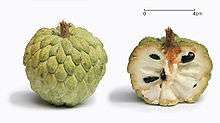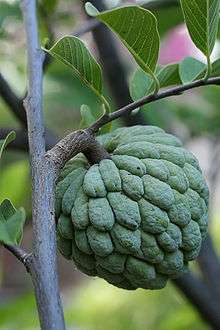Sugar-apple
The sugar-apple, sweetsop, or custard apple is the fruit of Annona squamosa, the most widely grown species of Annona and a native of the tropical Americas and West Indies. The Spanish traders of Manila galleons brought it to Asia where its old Mexican name ate may still be found in Bengali ata, Nepalese aati, Sinhalese mati anoda, Burmese awzar thee, Indonesia “ Srikaya”’ and atis in the Philippines. It is also known as sharifa in India,(mainly Annona reticulata) in the Philippines and in Australia.[1] The name is also used in Portuguese as ata.
The fruit is spherical through conical, 5–10 cm (2.0–3.9 in) in diameter and 6–10 cm (2.4–3.9 in) long, and weighing 100–240 g (3.5–8.5 oz), with a thick rind composed of knobby segments. The color is typically pale green through blue-green, with a deep pink blush in certain varieties, and typically has a bloom. It is unique among Annona fruits in being segmented, and the segments tend to separate when ripe, exposing the interior.
The flesh is fragrant and sweet, creamy white through light yellow, and resembles and tastes like custard. It is found adhering to 13-to-16-millimetre-long (0.51 to 0.63 in) seeds forming individual segments arranged in a single layer around a conical core. It is soft, slightly grainy, and slippery. The hard, shiny seeds may number 20–40 or more per fruit and have a brown to black coat, although varieties exist that are almost seedless.[1][2]
There are also new varieties being developed in Taiwan. The atemoya or "pineapple sugar-apple," a hybrid between the sugar-apple and the cherimoya, is popular in Taiwan, although it was first developed in the US in 1908. The fruit is similar in sweetness to the sugar-apple but has a very different taste. As its name suggests, it tastes like pineapple. The arrangement of seeds is in spaced rows, with the fruit's flesh filling most of the fruit and making grooves for the seeds, instead of the flesh occurring only around seeds.
Nomenclature

As a result of its widespread cultivation, many local names have developed for the fruit.
- In English, it is most widely known as a sugar apple or sweetsop as well as a custard apple, especially in India and Australia (custard apple also refers to Annona reticulata, a closely related species).
- In Hispanic America, regional names include anón, anón de azucar, anona blanca, fruta do conde, cachiman, saramuyo, riñon,grenadilla(little grenade) and many others.
- In Arabic, it is called قشطة (qishta / ishta / ashta), the translation being "cream".
- In Aceh, it is called "seureuba".
- In Angola, it is called fruta-do-conde or fruta-pinha.
- In Assamese, it is called Atlos or অাতলচ.
- In Bambara, it is called zumzum or sunsun.
- In Bangladesh, it is called "Ata fol".
- In The Bahamas, it is called "sugar apple".
- In Brazil, it is called fruta-do-conde, fruta-de-conde, condessa, fruta-pinha, pinha (lit. cone), ata or anona.
- Its name in Burmese is ဩဇာသီး or aawză tē.
- In Cambodia, regional names include "plae teib".
- In Curacao, it is called "skopapel".
- In Ethiopia, it is called Gishta (ጊሽጣ) in Amharic.
- In Germany, it is called Zimtapfel, because of its taste.[3]
- In Ghana, it is called "Sweet Apple".
- In Greece, it is called γλυκόμηλο (sweet apple).
- In Haiti, it is called kachiman.
- In Hong Kong, it is called foreign lychee (番鬼荔枝).
- In Iceland, it is called sólberkja.
- In India it is known as: Sitaphal in most languages, literally meaning Sita's fruit
In Bengali: ata (আতা)
In Gujarati: sitaphal (સીતાફળ)
In Hindi: sharifa (शरीफ़ा)
In Bhojpuri: sharifa (शरीफ़ा)
In Kannada: sitaphala (ಸೀತಾಫಲ)
In Malayalam: aathakka (ആത്തക്ക) / seethappazham (സീതപ്പഴം)
In Marathi: sitaphal (सीताफळ)
In Odia: aata (ଆତ)
In Punjabi: sharifa (ਸ਼ਰੀਫਾ)
In Tamil: sitappalam (சீதாப்பழம்)
In Telugu: sita phalamu (సీతా ఫలము). - In Indonesia, srimatikiya or, as mostly people call it, srikaya.
- In Jamaica, it is called "sweetsop" or "sweet-sop".
- in Japan, it is called shakatou (釈迦頭, head of Shakyamuni).
- In Kenya, it is called matomoko.
- In Madagascar, it is called konikony in Malagasy, or pocanelle in French.
- In Malawi, it is called "mpoza" in chewa.
- In Malaysia, it is called buah nona.
- In Mauritius, it is called "zatte" in the Creole language.
- In Martinique it is called pomme cannelle.
- In Mozambique it is called ata.
- In Nepal, it is called "aati" as well as "saripha" (सरीफा).
- In Nicaragua, it is called "annona guatemala".
- In Northern Nigeria, it is called fasadabur in Hausa
- In Pakistan, it is called Sharifa (شريفا)
- In the Philippines, it is called atis.
- In Singapore, it is called Lim kim.
- In Sri Lanka, it is called "Anoda" or "Katu Atha" in Sinhalese, "Annamunnaa" (அன்னமுன்னா) in Tamil.
- In Taiwan, it is called sakya (Chinese: 釋迦; pinyin: shìjiā; Taiwanese: sek-khia, sek-kia) because one cultivar resembles the top part of Shakyamuni's (釋迦牟尼) head.
- In Tanzania, it is called matopetope.
- In Thailand, it is called noi-na (น้อยหน่า).
- In Uganda, it is called ekistaferi.
- In Vanuatu, it is called korosol or pomkanel.
- In Vietnam, it is called mãng cầu ta or na.
- In Yemen, it is called Khirmish (خرمش).
- In Oman, it is called Sa'fal (سعفل).
Nutrition and uses
| Nutritional value per 100 g (3.5 oz) | |
|---|---|
| Energy | 393 kJ (94 kcal) |
|
23.64 g | |
| Dietary fiber | 4.4 g |
|
0.29 g | |
|
2.06 g | |
| Vitamins | Quantity %DV† |
| Thiamine (B1) |
10% 0.11 mg |
| Riboflavin (B2) |
9% 0.113 mg |
| Niacin (B3) |
6% 0.883 mg |
| Pantothenic acid (B5) |
5% 0.226 mg |
| Vitamin B6 |
15% 0.2 mg |
| Folate (B9) |
4% 14 μg |
| Vitamin C |
44% 36.3 mg |
| Minerals | Quantity %DV† |
| Calcium |
2% 24 mg |
| Iron |
5% 0.6 mg |
| Magnesium |
6% 21 mg |
| Manganese |
20% 0.42 mg |
| Phosphorus |
5% 32 mg |
| Potassium |
5% 247 mg |
| Sodium |
1% 9 mg |
| Zinc |
1% 0.1 mg |
|
| |
| |
|
†Percentages are roughly approximated using US recommendations for adults. Source: USDA Nutrient Database | |
Sugar-apple is high in energy, an excellent source of vitamin C and manganese, a good source of thiamine and vitamin B6, and provides vitamin B2, B3 B5, B9, iron, magnesium, phosphorus and potassium in fair quantities.[4]
A Philippine company produces sugar apple wine.
For uses of other fruit from the Custard-apple family see:
- Atemoya (a hybrid between A. squamosa and A. cherimoya)
- Cherimoya
- Custard-apple
Gallery
 Sugar apple in Tamil Nadu, which is known as சீதாபழம்
Sugar apple in Tamil Nadu, which is known as சீதாபழம் Sugar apple (right), with Taiwanese "pineapple shijia" (atemoya) (left)
Sugar apple (right), with Taiwanese "pineapple shijia" (atemoya) (left)_interior.jpg) The sugar apple readily breaks open when ripe.
The sugar apple readily breaks open when ripe. A deconstruction of a sugar apple, showing a lobe of fruit and pulpy segments with seeds.
A deconstruction of a sugar apple, showing a lobe of fruit and pulpy segments with seeds. A sugar apple ready to eat
A sugar apple ready to eat Red Sugar Apples from Myanmar
Red Sugar Apples from Myanmar
See also
References
- 1 2 Morton, Julia (1987). "Annona squamosa". Fruits of warm climates. p. 69. Retrieved 6 March 2013.
- ↑ "Annona squamosa". AgroForestryTree Database. Archived from the original on 14 March 2007. Retrieved 16 September 2013.
- ↑ Bernd Nowak, Bettina Schulz: Taschenlexikon tropischer Nutzpflanzen und ihrer Früchte. Quelle&Meyer, Wiebelsheim 2009, ISBN 978-3-494-01455-5, p. 57–59.
- ↑ "Benefits of Custard apple". 22 December 2014.
External links
| Wikimedia Commons has media related to Annona squamosa. |
| Wikisource has the text of a 1911 Encyclopædia Britannica article about Sugar-apple. |
- Flora of North America: Annona squamosa
- "Annona squamosa". Germplasm Resources Information Network (GRIN). Agricultural Research Service (ARS), United States Department of Agriculture (USDA).
- Fruits from Americas: Annona squamosa
- Pacific Island Ecosystems at Risk: Annona squamosa
- Growing Sugar Apple Annona squamosa
